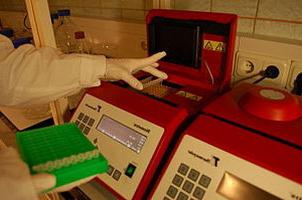Polymerase chain reaction (PCR) is a molecular biology method that allows you to detect small amounts of deoxyribonucleic acid (DNA) in biological material , more precisely, certain fragments of it, and multiply them many times over. They are then visually identified by gel electrophoresis. The reaction was developed in 1983 by K. Mullis and is included in the list of outstanding discoveries of recent years.
What are the mechanisms of PCR
The whole technique is based on the ability of nucleic acids to independently replicate, which in this case is carried out artificially in a laboratory. DNA reproduction can begin not in any area of the molecule, but only in areas with a specific nucleotide sequence - starting fragments. In order for the polymerase chain reaction to begin, primers (or DNA probes) are needed. These are short fragments of a DNA chain with a given nucleotide sequence. They are complementary (i.e. corresponding) to the start regions of the sample DNA.

Of course, in order to create primers, scientists must study the nucleotide sequence of the nucleic acid that is involved in the procedure. It is these DNA probes that provide the specificity of the reaction and its initiation. A polymerase chain reaction will not work if at least one molecule of the desired DNA is not found in the sample. In general, for the reaction, the above primers, a set of nucleotides, and heat-resistant DNA polymerase are required. The latter is an enzyme - a catalyst for the synthesis of new nucleic acid molecules based on a sample. All these substances, including biological material in which it is necessary to detect DNA, are combined into a reaction mixture (solution). It is placed in a special thermostat, performing its very rapid heating and cooling in a given time - a cycle. Usually there are 30-50 of them.
How does this reaction go?
Its essence is that during one cycle, the primers attach to the desired DNA sites, after which it doubles under the action of the enzyme. Based on the resulting DNA strands in subsequent cycles, new and new identical fragments of the molecule are synthesized.
The polymerase chain reaction proceeds sequentially, its following stages are distinguished. The first is characterized by doubling the amount of product during each heating and cooling cycle. In the second stage, the reaction slows down, since the enzyme is damaged and also loses activity. In addition, nucleotide and primer stores are depleted. At the last stage - the plateau - the products no longer accumulate, as the reagents have run out.
Where is it used
Undoubtedly, polymerase chain reaction finds wide application in medicine and science. It is used in general and private biology, veterinary medicine, pharmacy and even ecology. Moreover, in the latter this is done to track the quality of food and environmental objects. The polymerase chain reaction is actively used in forensic practice to confirm paternity and to identify a person. In forensic examination, as well as in paleontology, often this technique is the only way out, since usually an extremely small amount of DNA is available for research. Of course, the method has found very wide application in practical medicine. It is necessary in such areas as genetics, infectious and oncological diseases.